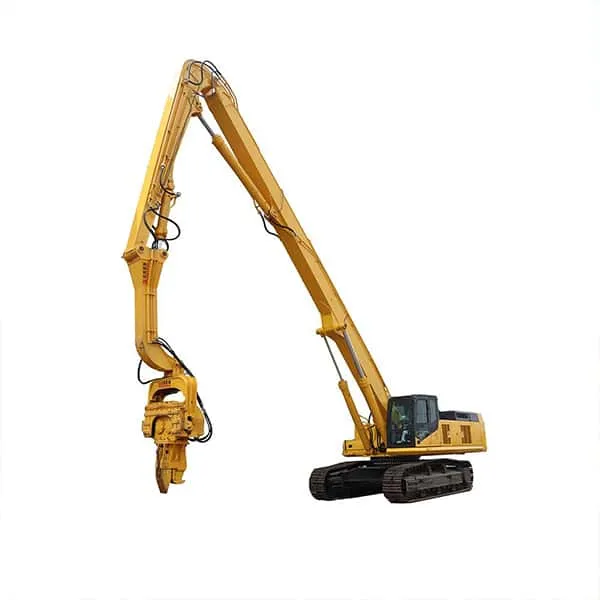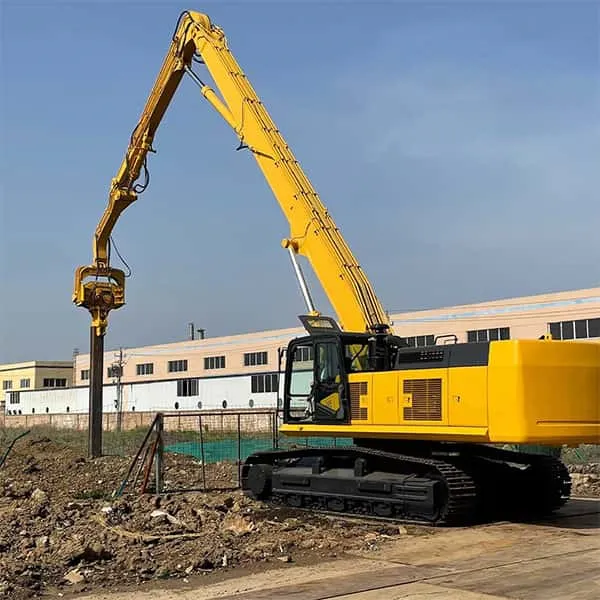Introduction

Pile driving involves hammering long columns of wood, concrete or steel into the ground to create foundations for buildings, bridges and other structures. Powerful piledriving equipment generates enormous downward energy, forcing piles hundreds of feet into subsurface materials.
However, piledriver construction brings unique challenges requiring specialized equipment knowledge and operational diligence to overcome. Understanding common difficulties helps contractors plan appropriate solutions before projects begin.
In this comprehensive guide, we will cover:
Table des matières
Gaining insight into the demanding work of delivering stable, load-bearing foundations via piledrivers allows shoring up operational weak spots in advance.
Overview of Piledriving Methods
Two major methods dominate piledriving work:
Impact Hammers – Giant mechanical winches raise heavy metal rams (up to 26 tons) that free-fall downward, hammering pile tops with tremendous kinetic energy. Diesel powered versions add versatility. High productivity but noisy with vibration issues.
Vibratory Drivers – Hydraulic motor-powered eccentric counterweights create vertical oscillating forces (40,000+ lb) shaking piles into soils at high frequencies. Faster in some conditions but less penetration depth capability versus impact methods. Lower noise/vibration disruptions.
Choosing approach depends on pile materials, load capacities and substrate conditions. Most contractors utilize both techniques across projects.
Major Piledriving Challenges

While critical for infrastructure, piledriving brings difficulties:
Access Issues – Transporting and positioning heavy equipment on congested urban build sites strains logistics. Mobilizing in remote terrain or working over water adds complications.
Penetration Problems – Unexpectedly dense subsurface obstacles like boulders or concrete stop pile advancement despite substantial hammer energy, requiring time-consuming solutions.
Pile Alignment & Positioning – Leaning foundations compromise structural integrity. Slow precise repositioning delays progress.
Vibrations & Disturbances – Ram hammering sends strong tremor waves through soils that can damage nearby structures. Noise annoys communities.
Equipment Breakdowns – Harsh site conditions strain delicate piledriver components. failures bring operations to a halt.
Staying atop of these common issues ensures steady, quality productivity.
Technology & Techniques to Aid Projects
Specialized equipment and rigging approaches help confront project challenges:
Powerful Cranes & Booms – Strong overhead equipment with sufficient reach enables positioning piles and driving frames into awkward spaces that cannot be accessed directly at ground level around existing infrastructure.
Equipment for Accessing Tough Piledriving Sites:
| Equipment | Description |
|---|---|
| All-Terrain Cranes | Traveled while erected for nimble siting |
| Spider Cranes | Extendable outriggers crest obstacles |
| Launch Gantries | Tall, fixed platforms elevate heavy machinery above sites |
Sonic Integrity Testing – Sensors analyze hammer-induced pile vibrations, generating subsurface profiles assessing obstructions and load capacities by depth without excavation.
Hydraulic Jacks & Winches – Finesse positioning adjustments needed to straighten slightly canted piles for proper vertical alignment.
Investing in supplemental tools pays dividends conquering common difficulties.
Choosing the Optimal Piledriver

With diverse models and customization options, ideal piledriver selection requires factoring:
Pile Types & Sizes – Hammer energy, driving frames and available accessories must match project material and diameter specs to handle loads.
Penetration Depth – Maximum pound-feet driving forces dictate feasible subsurface depths across terrain conditions present. Add safety margin.
Site Restrictions – Dimensional clearances and allowable noise/vibration emissions alter suitable rig choices, ruling out unworkable piledrivers, regardless of productivity metrics.
Mobility Needs – Truck or crawler transport determines feasible location access around existing structures and infrastructure barriers to navigation.
While maximum rated productivity captivates buyers, also confirm flexibility coping with site-specific unknowns.
Preparing for Problems
Taking contingency precautions prepares teams managing issues:
- Stock extra hydraulic hoses, filters, wear plates subject to pounding pressures. Replace routinely.
- Prepare crane mats and dynamic compaction equipment to remedy difficult digging areas.
- Stage tools and procedures for pile extraction when insurmountable blockages arise.
- Ensure adequate supply inventory for pile modification and reinforcement to overcome subsurface snags.
- Have noise and vibration monitoring kits ready for inspections assuaging community concerns if disputes arise.
- Brief contractors on contingency workflows accounting for equipment failures or access restrictions.
Brainstorming solutions in advance minimizes delays when challenges emerge. Smooth progress preserves budgets.
Conclusion
Delivering stable structural foundations via piledriving requires facing unpredictable subsurface obstacles that batteries of tests never fully reveal in advance. Yet foresight on common equipment and site challenges allows contractors to prepare an arsenal of technological aids and responsive procedures to overcome issues expeditiously. Keeping piledrivers punching down payloads securely and efficiently pays dividends for all complex infrastructure projects.
FAQs: Piledriver Construction
How deep can impact pile drivers and vibratory drivers penetrate?
Impact hammers have achieved well over 400 ft in ideal conditions, though 60-100 ft depths suit most civil applications. Vibratory drivers manage around half the penetration since vibrations dissipate with depth but reduce site disturbances.
What is the typical life expectancy of piledriving equipment?
With adequate maintenance replacing high-wear components like hydraulic lines and bearings, both impact and vibratory piledrivers often log 20,000+ hours over 20+ year lifetimes. Infrastructure longevity depends more on availability of spare parts.
How close can you safely drive piles next to existing structures?
Consult geotechnical assessments of subsurface conditions and foundation loads. As a general guideline, maintain a separation distance at least 5 times the pile diameter, taking vibrations into account. More for vulnerable buildings.
When assessing tender bids, what key productivity specifications should be reviewed?
Tonnage striking force, stroke height and blows per minute indicate impact hammer potential rates. For vibratory drivers, eccentric moment, frequency ranges and adjustable power levels dictate penetration output across various geologies.
How much vibration monitoring is necessary during commercial piledriving?
Many jurisdictions mandate baseline monitoring with seismographs before, intermittently during, and after pile installation near buildings. Thermographic imaging may also be specified post-project to verify cracks did not form over time.






-150x150.webp)
